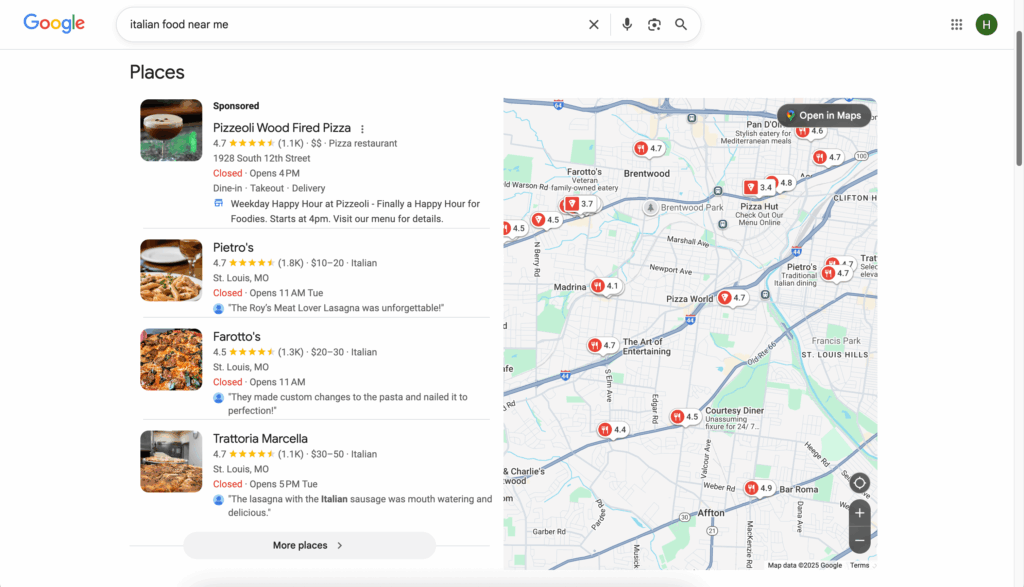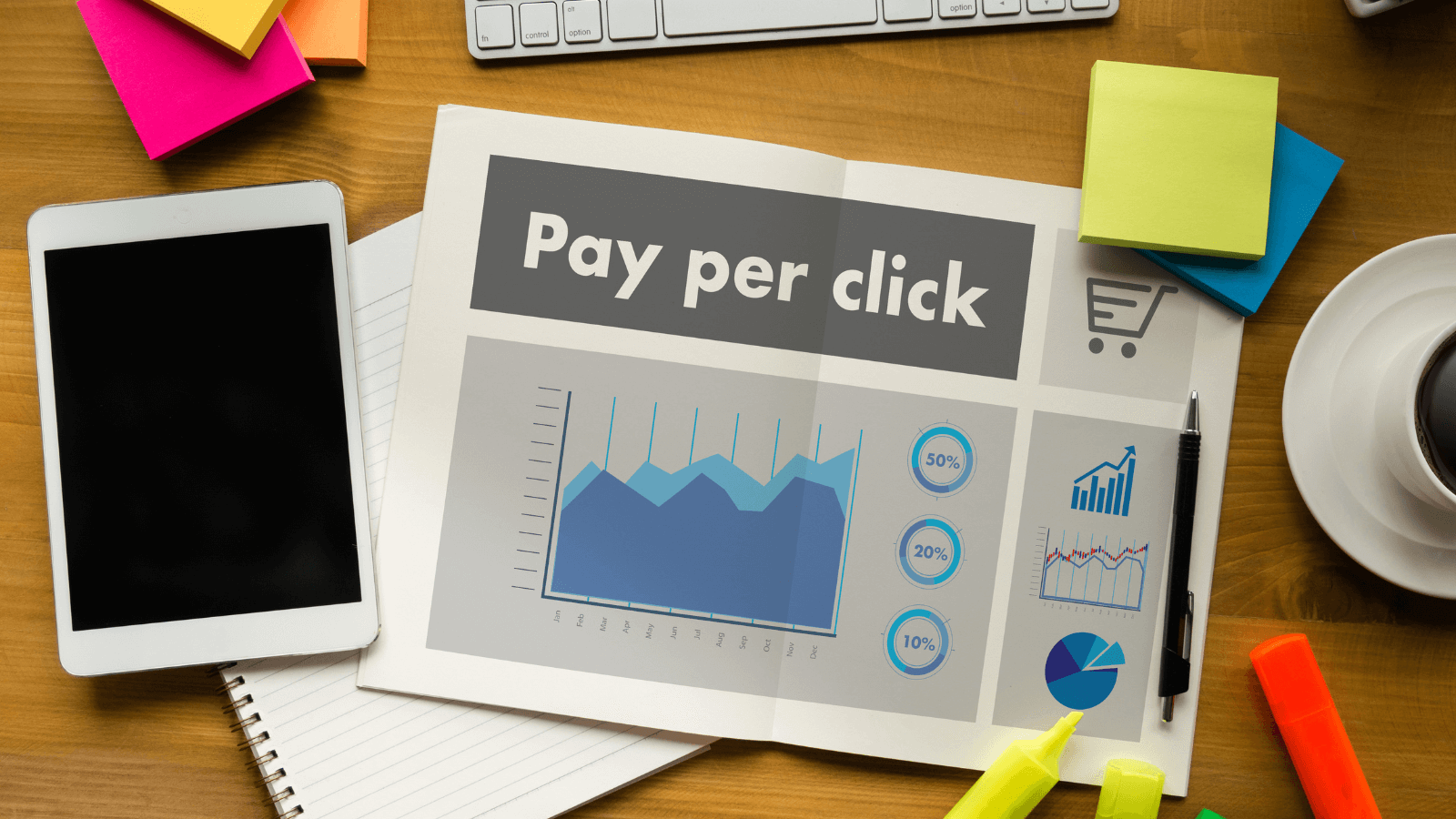Have you ever been tasked to answer the dreaded “what should we do for dinner” question? A conversation that seems never-ending because every participant either has no opinion or shoots down any suggestion. This conversation usually ends with someone suggesting a type of food, like Mexican or Italian, and everyone agrees they could eat that option. Then you whip out your phone and search “Mexican food near me“, find a restaurant everyone agrees with, and go on your merry way.
The key to solving the “what should we do for dinner” question is actually a “near me” search, also known as a local search. These searches are essential to business owners because users are close to making a purchase. In fact, 76% of consumers who search “near me” visit a business within a day. These searches have high intent because they occur so close to the moment of purchase.
This guide will break down the tactics you will need to rank for “near me” keywords. You’ll get simple local SEO checklists, practical advice on Google Business Profile, link building, review strategies, and real-world tips for tracking and improving results over time. By the end, you will have actionable steps and clear wins in local search results!
Local SEO Fundamentals
To rank well for “near me” keywords, you first need to understand the force behind ranking for these terms, and that force is local SEO. Local SEO is the process of optimizing a business’s online presence to attract more customers from relevant local searches. In this process, you are trying to capture as many searchers in your area as you can. In general SEO, you compete for broad terms and searchers who could be anywhere, whereas in local SEO, you compete for slightly more specific terms and searchers in your local area. To have a complete digital marketing strategy, you need to be optimizing for local search.
There are three main ranking factors that the Google algorithm uses when serving local search rankings. The first factor is relevance, or how well your business matches the user’s search query. The second one is distance, or how far your business is from the searcher. The third factor is prominence, or how well-known the business is in the surrounding area. When trying to capture “near me” searches, you need to optimize for these three factors, starting with your Google Business Profile.
Google Business Profile: The First Priority
Your Google Business Profile (GBP), previously known as Google My Business, is the most essential thing you can control when trying to rank for “near me” searches. Your GBP acts as a digital storefront for your business, displaying key business information such as location, hours, photos, and reviews. Here is an example of how GBPs appear in search results:

Your GBP allows you to appear in Google Search and Google Maps. Your GBP is where you can update all the information needed to rank for “near me” searches. Here is a checklist of things to do to optimize your listing:
- Claim and verify your GBP listing: First, make sure you have claimed your business profile. Google creates business listings from local directories and public records, but it is of no use to you until you claim the profile and verify that your business is legit. If you have multiple physical locations, be sure to claim the profiles for each location.
- Important Update: Ensure your business name, address, phone number, and hours are correct. Be sure to update this information whenever it changes; for example, if you have special holiday hours, be sure to update them so users are aware. Making sure your business hours are correct is extremely important. If your hours are listed as 9 am-5 pm but you are actually open 9 am-7 pm, you will miss out on searches from 5 pm-7 pm because Google won’t serve closed businesses when others are open.
- Select relevant categories: When choosing your primary category, pick one that represents your niche. A common error business owners make is picking a broad category like “Restaurant” instead of a specific one like “Mexican Restaurant”. The theory is that you will catch more searchers with the broader category. Still, the reality is you won’t rank as well in the broad category because there are so many businesses in this category.
- Include all your services and products: Be sure to add them to your GBP. Once you add your products and services, be sure to complete the descriptions, adding any local search terms where they naturally fit.
- Add detailed business descriptions with localized keywords: It is essential when you are writing your business description to use a lot of the local keywords you are hoping to rank for. Be sure to add location-based keywords like “Mexican restaurant in St. Louis” and “Mexican restaurant with delivery” to rank well for local searches. It is important to note that you shouldn’t stuff as many keywords as possible, as that can come off as spammy and could get your account suspended.
- Upload high-resolution photos and videos showcasing your business. Photos will make your profile more engaging by showing potential customers what they can expect when visiting your business. These photos will also help Google better understand your business type and atmosphere.
- Encourage and respond to customer reviews regularly: Reviews are one of the three key ranking factors for local search: prominence. Be sure to encourage customers to leave a review after each transaction, and respond to all reviews (positive and negative) to show Google and users that you care about your customers.
- Post updates, offers, and Q&A content directly on GBP: Share regular posts, special offers, and timely information to keep your profile fresh. Active engagement will encourage clicks, help convert searchers into customers, and keep your community updated on new business developments.
On-Page Optimizations for Your Website
Once you have your GBP optimized for local searches, it’s time to optimize your website for local searches. Your website content will give Google context for all the services you provide and the area you serve. Here are a few things you can add to your website to help you rank better for “near me” searches:
- Build location and service pages that address local intent: Your site should include pages for the locations you serve, along with subpages for each service area that list the services you provide. For example, suppose you are a Texas-based plumber who services Houston, Dallas, and Austin. In that case, you should build location pages for each city and subpages for each service you provide (e.g., Houston Plumbing, Houston Drain Cleaning, and Houston Water Heater Installation).
- Maintain consistent business name, address, and phone number (NAP) across all website pages: Ensuring your name, address, and phone number are consistent across all your webpages will build trust and authority with users and Google.
- Use local business schema markup: Properly adding this structured data ensures your information appears correctly in search engine results pages. Schema will also help you rank in different features on SERPs.
- Optimize meta titles and descriptions for “near me” intent: Use “near me” and other local terms, such as neighborhoods, naturally in your meta descriptions to give Google and users clear context about where you are located and what you do.
Optimizing for Mobile Searches

Most “near me” searches, a whopping 84%, are done on mobile devices. This means that mobile optimization is crucial for ranking for these searches. The key to mobile optimization is user experience. Every aspect of your site should translate to mobile and provide a positive mobile user experience. The better the user experience, the lower your site’s bounce rate, which signals to Google that your site is relevant and user-friendly.
To ensure a mobile-friendly user experience, include responsive design and easy navigation to accommodate all screen sizes; click-to-call buttons; integrated maps for quick actions; fast page load times aligned with mobile Core Web Vitals; and location-based content that dynamically adjusts to user location and preferences.
Building up Your Local Reputation
Your business’s reputation is one of the key aspects of the prominence ranking factor for local SEO. There are two essential aspects of your online reputation: reviews and local visibility.
Review Management
Reviews both on your GBP and directories like Yelp have a significant impact on your rankings for “near me” keywords. Here are three actionable things you can do to improve your rankings and reviews:
- Request reviews at key customer touchpoints (post-purchase, follow-up emails).
- Respond promptly to both positive and negative feedback.
- Highlight positive reviews on your website and social media.
Increasing Your Local Visibility
The best way to increase your local visibility is through social media. Here are three ways you can utilize social media to help improve your local visibility:
- Share local content. This can be content about your business participating in local events, updates about your different locations, or employee and customer spotlights.
- Use local geotags and hashtags. Tag your posts with relevant hashtags and geotags to help users associate your content with those locations.
- Partner with local influencers to expand reach. Partnering with local influencers is a great way to get your name out to more people and increase your local visibility.
FAQs
What is local SEO?
Local SEO is the practice of optimizing your online presence to appear in Google search results for location-based queries. The main goal of local SEO is to connect businesses with customers nearby.
How to rank higher in local search?
To rank higher, focus on optimizing your Google Business Profile with accurate info, maintain consistent NAP (name, address, and phone number) across all digital platforms, build localized landing pages on your website, and ensure your site is mobile-friendly with fast load times. Encouraging and managing reviews on your GBP and directories also boosts your prominence with Google.
Is learning how to rank for "near me" searches worth it?
Absolutely! “Near me” searches are high-intent queries, and most users take action quickly: 76% visit a business within a day. These searches are also growing at a considerable rate, 900% YoY. Ranking well for these searches means you get in front of customers ready to purchase, making your local SEO efforts a powerful driver of real revenue.
Where should I use "near me" keywords?
Use “near me” and related local terms naturally in your Google Business Profile descriptions, website meta titles, title tags, headers, and page content. Include them in service or location-specific landing pages, and in posts or updates you share on GBP. Avoid stuffing by focusing on context and user intent.
What strategies can help improve rankings for "near me" keywords in local searches?
The best strategies include maintaining a complete Google Business Profile, optimizing on-page content with localized keywords, enhancing the mobile user experience, actively managing your Google reviews, and leveraging social media and local influencer partnerships to boost local engagement and authority.
Key Takeaways
To have a complete digital marketing strategy, you need to be optimizing for local search. Ranking for “near me” keywords hinges on mastering local SEO fundamentals. Understanding Google’s focus on relevance, distance, and prominence as the ranking factors for local search, and optimizing your Google Business Profile to align with these three pillars.
Your GBP should include accurate information, detailed descriptions, and visual content to build trust with users and Google by providing more context about your business. Your entire online presence should have a consistent NAP to avoid confusing users and Google.
Strong on-page SEO and mobile optimization will ensure you meet users where they search and when they act. While reviews and social media engagement will bolster your reputation and local visibility, they will also increase your chances of appearing in high-intent local searches.
Ready to turn “near me” searches into real customers? Let the Digital Strike team craft a tailored local SEO strategy that gets your business discovered right when it matters most.





